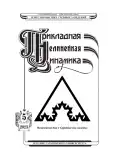Mutual synchronization of oscillations in a system of coupled evolutionary games
- Authors: Vershinina O.S.1, Ivanchenko M.V.1
-
Affiliations:
- Lobachevsky State University of Nizhny Novgorod
- Issue: Vol 31, No 5 (2023)
- Pages: 610-621
- Section: Articles
- URL: https://journals.rcsi.science/0869-6632/article/view/251292
- DOI: https://doi.org/10.18500/0869-6632-003056
- EDN: https://elibrary.ru/WTYVYA
- ID: 251292
Cite item
Full Text
Abstract
The purpose of this study is to investigate collective dynamics of coupled communities that evolve according to the population game «Battle of the Sexes». A separate community includes two interacting populations of players of opposite sex, where each player has one of two possible competing behavior strategies. It is necessary to determine the possibility of mutual synchronization of oscillations in the number of players adhering to a particular strategy, build a synchronization region, and also evaluate the dependence of the properties of oscillations on the coupling strength. Methods. In this paper, we study the system of evolutionary games «Battle of the Sexes» interacting through migration. To simulate the evolutionary game dynamics we make use of the stochastic Moran process, as well as the Monte Carlo method to sample game trajectories. Mutual synchronization is defined by the appropriately generalized criteria of frequency and phase locking. Results. It is shown that the system of coupled evolutionary games «Battle of the Sexes» demonstrates mutual synchronization of oscillations under sufficiently strong coupling. In particular, oscillation frequencies of two communities get adjusted to each other and begin to coincide at some interaction parameter, while the oscillations themselves become almost identical. A similar result was also observed for an ensemble of more than two communities. Conclusion. The dependence of the average frequencies of community oscillations on the coupling strength was determined, the adjustment of oscillations with an increase in the coupling strength was demonstrated, thereby showing the possibility of mutual synchronization in the model of coupled evolutionary games «Battle of the Sexes». The region of frequency synchronization was numerically found.
About the authors
Olga Sergeevna Vershinina
Lobachevsky State University of Nizhny Novgorod
Email: olya.vershinina@itmm.unn.ru
ORCID iD: 0000-0002-3917-9592
Scopus Author ID: 57195273479
ResearcherId: AAJ-7282-2020
603950 Nizhny Novgorod, Gagarin Avenue, 23
Mihail Vasilevich Ivanchenko
Lobachevsky State University of Nizhny Novgorod
Author for correspondence.
Email: ivanchenko@unn.ru
603950 Nizhny Novgorod, Gagarin Avenue, 23
References
- Pikovsky A, Rosenblum M, Kurths J. Synchronization: A Universal Concept in Nonlinear Sciences. New York: Cambridge University Press; 2001. 411 p. doi: 10.1017/CBO9780511755743.
- Neiman A, Pei X, Russell D, Wojtenek W, Wilkens L, Moss F, Braun HA, Huber MT, Voigt K. Synchronization of the noisy electrosensitive cells in the paddlefish. Phys. Rev. Lett. 1999;82(3): 660–663. doi: 10.1103/PhysRevLett.82.660.
- Schafer C, Rosenblum MG, Abel HH, Kurths J. Synchronization in the human cardiorespiratory system. Phys. Rev. E. 1999;60(1):857–870. doi: 10.1103/PhysRevE.60.857.
- Tass P, Rosenblum MG, Weule J, Kurths J, Pikovsky A, Volkmann J, Schnitzler A, Freund HJ. Detection of n:m phase locking from noisy data: Application to magnetoencephalography. Phys. Rev. Lett. 1998;81(15):3291–3294. doi: 10.1103/PhysRevLett.81.3291.
- Amiri M, Bahrami F, Janahmadi M. Functional contributions of astrocytes in synchronization of a neuronal network model. Journal of Theoretical Biology. 2012;292:60–70. doi: 10.1016/j.jtbi. 2011.09.013.
- Blasius B, Huppert A, Stone L. Complex dynamics and phase synchronization in spatially extended ecological systems. Nature. 1999;399(6734):354–359. doi: 10.1038/20676.
- Simonis JL. Demographic stochasticity reduces the synchronizing effect of dispersal in predator– prey metapopulations. Ecology. 2012;97(3):1517–1524. doi: 10.1890/11-0460.1.
- Shabunin AV. Synchronization of infections spread processes in populations interacting: Modeling by lattices of cellular automata. Izvestiya VUZ. Applied Nonlinear Dynamics. 2020;28(4):383–396 (in Russian). doi: 10.18500/0869-6632-2020-28-4-383-396.
- Smith JM. Evolution and the Theory of Games. Cambridge: Cambridge University Press; 1982. 234 p. doi: 10.1017/CBO9780511806292.
- Dawkins R. The Selfish Gene. Oxford: Oxford University Press; 1976. 224 p.
- Nowak MA, Sasaki A, Taylor C, Fudenberg D. Emergence of cooperation and evolutionary stability in finite populations. Nature. 2004;428(6983):646–650. doi: 10.1038/nature02414.
- Taylor C, Fudenberg D, Sasaki A, Nowak MA. Evolutionary game dynamics in finite populations. Bull. Math. Biol. 2004;66(6):1621–1644. doi: 10.1016/j.bulm.2004.03.004.
- Vershinina O, Ivanchenko M, Denisov S. Quasi-stationary oscillations in game-driven evolutionary dynamics. Cybernetics and Physics. 2019;8(4):307–311. doi: 10.35470/2226-4116-2019-8-4-307- 311.
- Traulsen A, Claussen JC, Hauert C. Coevolutionary dynamics: From finite to infinite populations. Phys. Rev. Lett. 2005;95(23):238701. doi: 10.1103/PhysRevLett.95.238701.
- Rosenblum M, Pikovsky A, Kurths J, Schafer C, Tass PA. Chapter 9 Phase synchronization: From theory to data analysis. In: Moss F, Gielen S, editors. Handbook of Biological Physics. Vol. 4. Elsevier Science; 2001. P. 279–321. doi: 10.1016/S1383-8121(01)80012-9.
- Holt CA, Roth AE. The Nash equilibrium: a perspective. Proc. Natl. Acad. Sci. U. S. A. 2004;101(12):3999–4002. doi: 10.1073/pnas.0308738101.
Supplementary files










